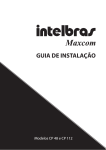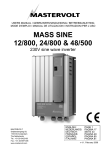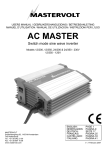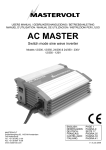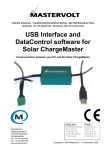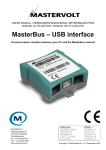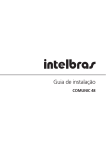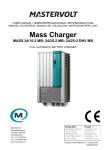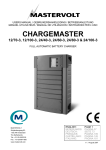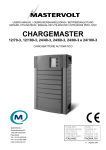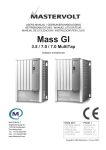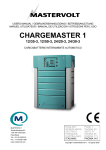Download Mass Systemswitch
Transcript
USERS MANUAL / GEBRUIKERSHANDLEIDING / BETRIEBSANLEITING MANUEL D’UTILISATION / MANUAL DE UTILIZACION Mass Systemswitch Automatic AC transfer switch MASTERVOLT Snijdersbergweg 93, 1105 AN Amsterdam The Netherlands Tel.: +31-20-3422100 Fax.: +31-20-6971006 www.mastervolt.com ENGLISH: NEDERLANDS: DEUTSCH: FRANÇAIS: CASTELLANO PAGE 1 PAGINA 29 SEITE 57 PAGINA 85 PÁGINA 113 v 2.1 May 2007 CONTENTS CONTENTS: v 2.1 May 2007 1 GENERAL INFORMATION............................................................................................................................. 4 1.1 Use of this manual .............................................................................................................................. 4 1.2 Guarantee Specifications ................................................................................................................... 4 1.3 Quality................................................................................................................................................. 4 1.4 Validity of this manual......................................................................................................................... 4 1.5 Liability................................................................................................................................................ 4 2 SAFETY GUIDELINES AND MEASURES ..................................................................................................... 5 2.1 Warnings and symbols ....................................................................................................................... 5 2.2 Use for intended purpose ................................................................................................................... 5 2.3 Organisational measures.................................................................................................................... 5 2.4 Warning of special dangers ................................................................................................................ 5 3 HOW IT WORKS............................................................................................................................................. 6 3.1 Source priority..................................................................................................................................... 6 3.2 AC inputs ............................................................................................................................................ 6 3.2.1 Only inverter power available.............................................................................................. 6 3.2.2 Shore power available......................................................................................................... 6 3.2.3 Generator power available .................................................................................................. 7 3.3 AC outputs .......................................................................................................................................... 7 3.3.1 Inverter only output (no break) ............................................................................................ 7 3.3.2 Short break output............................................................................................................... 7 3.3.3 Power output ....................................................................................................................... 7 3.3.4 Generator only output ......................................................................................................... 7 3.4 Monitoring and control ........................................................................................................................ 8 3.4.1 Remote control panel (optional) .......................................................................................... 8 3.4.2 MasterBus (optional) ........................................................................................................... 8 3.5 Load on inverter mode........................................................................................................................ 9 3.6 Automatic load on inverter mode........................................................................................................ 9 3.6.1 Use of a traditional remote control panel ............................................................................ 9 3.6.2 MasterBus ........................................................................................................................... 9 3.6.3 Example ............................................................................................................................ 10 4 INSTALLATION ............................................................................................................................................ 11 4.1 General ............................................................................................................................................. 11 4.2 Environment...................................................................................................................................... 11 4.3 Tools required for installation ........................................................................................................... 11 4.4 Mounting of the cabinet .................................................................................................................... 11 4.5 Opening the connection compartment.............................................................................................. 12 4.6 Wire cross section ............................................................................................................................ 12 4.7 Ground connections.......................................................................................................................... 13 4.8 Wiring................................................................................................................................................ 13 4.9 Inputs ................................................................................................................................................ 14 4.10 Outputs ............................................................................................................................................. 14 4.11 Remote panel (optional) ................................................................................................................... 14 4.12 MasterBus (optional)......................................................................................................................... 14 4.13 Commissioning after installation....................................................................................................... 15 4.13.1 MasterBus (optional) ......................................................................................................... 15 4.14 Decommissioning ............................................................................................................................. 15 4.15 Storage and transportation ............................................................................................................... 15 4.16 Re-installation ................................................................................................................................... 15 2 May 2007 / Mass Systemswitch / EN CONTENTS 5 MASTERBUS................................................................................................................................................ 16 5.1 What is MasterBus?.......................................................................................................................... 16 5.2 Event based commands ................................................................................................................... 16 5.3 How to set up a MasterBus network................................................................................................. 17 6 SPECIFICATIONS ........................................................................................................................................ 18 6.1 Technical data .................................................................................................................................. 18 6.2 Outline drawing................................................................................................................................. 19 6.3 MasterBus: Monitoring and Programming of the Mass Systemswitch ............................................. 20 6.3.1 Menu level 2: Monitoring ................................................................................................... 20 6.3.2 Menu level 3: History......................................................................................................... 20 6.3.3 Menu level 3: Configuration .............................................................................................. 21 6.3.4 List of event sources ......................................................................................................... 22 6.3.5 List of event commands .................................................................................................... 22 6.3.6 Personal settings and notes.............................................................................................. 23 7 ORDERING INFORMATION......................................................................................................................... 24 7.1 Traditional remote control panels ..................................................................................................... 24 7.2 MasterBus remote control panels..................................................................................................... 24 7.3 MasterBus installation components.................................................................................................. 25 7.4 Miscellaneous ................................................................................................................................... 25 8 EC DECLARATION OF CONFIRMITY......................................................................................................... 26 EN / Mass Systemswitch / May 2007 3 GENERAL INFORMATION 1 GENERAL INFORMATION The MASTERVOLT Mass Systemswitch is the heart of the AC installation. It is designed to take over manual switching between three different power sources. The Mass Systemswitch automatically transfers the available AC power source to the right outputs. Automatic switching between the power sources doesn’t only offer you more comfort; it also improves the safety on board. The switching between the power sources, which is done by means of relays, assures that no short-circuiting will occur. All models have three inputs: Generator, Shore, and Inverter. The Mass Systemswitch 10 and 16 models both have four outputs: Generator only, Power, Shortbreak and Inverter only. The Mass Systemswitch 6 has three outputs: Power, Shortbreak and Inverter only. It is therefore obligatory that every person who works with the Mass Systemswitch must be completely familiar with the contents of this manual, and that he / she carefully follows the instructions contained herein. The manual must be immediately accessible to the user. This manual has 8 chapters. The actual status of the Mass Systemswitch can be monitored by means of one of the following Mastervolt remote control panels - AC System Manager - AC System Manager + Whisper - Power System Control panel 3 AC/DC - Power System Control panel 4 AC/DC 1.3 Instead of using one of the above mentioned remote control panels, the Mass Systemswitch is also compatible to be used in the MasterBus network: a decentralized data network, giving you full control over the entire electrical installation 1.1 USE OF THIS MANUAL This manual serves as a guideline for the safe and effective operation, installation, maintenance and possible correction of minor malfunctions of the Mass Systemswitch. This manual is valid for the following models: Description Mass Systemswitch 6 Mass Systemswitch 10 Mass Systemswitch 16 4 Part number 55008005 55008105 55008205 1.2 GUARANTEE SPECIFICATIONS Mastervolt guarantees that this unit has been built in accordance with the legally applicable standards and specifications. Should work take place, which is not in accordance with the guidelines, instructions and specifications contained in the user manual, damage may occur and / or the unit may not fulfil its specifications. All these matters may mean that the guarantee may become invalid. QUALITY During the production and prior to their delivery, all our units are exhaustively tested and inspected. The guarantee period is two years. 1.4 VALIDITY OF THIS MANUAL All the specifications, provisions and instructions contained in this manual apply solely to the MASTERVOLT-delivered standard versions of the Mass Systemswitch. 1.5 LIABILITY MASTERVOLT can accept no liability for: x Consequential damage due to use of the Mass Systemswitch. x Possible errors in the manuals and the results thereof. CAREFUL! Never remove the type number plate. Important technical information required for service, maintenance & secondary delivery of parts can be derived from the type number plate. May 2007 / Mass Systemswitch / EN SAFETY GUIDELINES AND MEASURES 2 SAFETY GUIDELINES AND MEASURES 2.1 WARNINGS AND SYMBOLS WARNING Never use the Mass Systemswitch at locations where there is danger of gas or dust explosion!. Safety instructions and warnings are marked in this manual by the following pictograms: A procedure, circumstance, etc which deserves extra attention. CAREFUL! Special data, restrictions and rules with regard to preventing damage. WARNING A WARNING refers to possible injury to the user or significant material damage to the Mass Systemswitch if the user does not (carefully) follow the procedures. 2.2 3. Use other than as mentioned under 2 is not considered to be consistent with the intended purpose. MASTERVOLT is not liable for any damage resulting from the above. 2.3 The user must always: x have access to the user manual x be familiar with the contents of this manual. This applies particularly to Chapter 2, Safety Guidelines & Measures. USE FOR INTENDED PURPOSE 1. The Mass Systemswitch is constructed as per the applicable low voltage directive. 2.4 2. Use the Mass Systemswitch only: x x x x in a technically correct condition; in a closed room, protected against rain, moisture, dust and non condensing circumstances; observing the instructions and specifications in the manual. as a stand alone unit or in combination with one of the following Mastervolt remote control systems: - AC System Manager - AC System Manager + Whisper - Power System Control panel 3 AC/DC - Power System Control panel 4 AC/DC - MasterBus network EN / Mass Systemswitch / May 2007 ORGANISATIONAL MEASURES WARNING OF SPECIAL DANGERS 1. Check the wiring at least once a year. Defects such as loose connections, burnt wiring etc. must be corrected immediately. 2. Do not work on the Mass Systemswitch or the electrical system if it is still connected to a power source. Only allow changes in your electrical system to be carried out by qualified electricians. 3. Installation must be done in accordance with local standards. 4. Voltages above 34 V can be dangerous. Use caution and pay careful attention when installing the Mass Systemswitch. Avoid short circuiting. 5 HOW IT WORKS 3 HOW IT WORKS 3.2 SOURCE PRIORITY The Mass Systemswitch switches the right AC power source to the output(s). Therefore the Mass Systemswitch is equipped with a source priority. If more than one AC power source is available, the source with the highest priority is switched to the output(s). See figure 1. The generator input has the highest priority: when generator power is available, all outputs (except the inverter only output) are supplied by the generator. Power on the shore input and/or the inverter input will be denied even when they are available. The shore input has the second priority. If there is no generator power available, shore power will be transferred to the power output and the short break output. Power on the inverter input will be denied. The lowest priority is assigned to the inverter. AC power on the inverter input is transferred to the short break output only when no other power source is available. Three AC-sources can be connected to the Mass Systemswitch: x Inverter power (IN3), x Shore power (IN2) x Generator power (IN1) 3.2.1 Only inverter power available When there is no AC power available on the generator input or the shore input, power from the inverter input is transferred to the short break output only. The power output and the generator only output are unavailable now. The Mass Systemswitch is in a neutral state and consumes no energy it self. 3.2.2 Shore power available When there is no generator power available but AC power is available on the shore input, the Mass Systemswitch will supply both the power output and the Short break output with AC power from the shore input. The generator only output is unavailable now. GENERATOR ONLY OUTPUT GENERATOR INPUT -------- INPUTS -------- AC INPUTS POWER OUTPUT SHORE INPUT SHORT BREAK OUTPUT INVERTER INPUT CPU Remote panel panel INVERTER ONLY OUTPUT ------------ OUTPUTS ------------ 3.1 Figure 1: principle schematics of the Mass Systemswitch 6 May 2007 / Mass Systemswitch / EN HOW IT WORKS 3.2.3 Generator power available When the generator is started, a control circuit samples its output voltage and frequency. Only when both are within allowed limits for approximately 10 seconds, the Mass Systemswitch transfers the power from the generator input to all outputs (except the inverter only output). Too low generator frequency and voltage may cause damage to both the generator and the connected load. Therefore AC power on the generator input is continuously checked by a control circuit. If the generator frequency or voltage is too low, generator power is immediately cut of from the load. The 10 seconds time delay provides an ‘easy start up’ for the generator. This increases the generator’s lifetime. 3.3 AC OUTPUTS The Mass Systemswitch has the following ACoutputs: x Inverter only output x Short break output x Power output x Generator only output* *not available on the Mass Systemswitch 6 3.3.1 Inverter only output (no break) The Inverter only output is directly powered by the inverter. This means that this output will never be transferred to one of the other AC sources. Critical loads like a computer or navigations equipment which are sensitive for voltage drops should be connected to this output. 3.3.2 Short break output The Short break output is transferred between the generator input, shore input and inverter input, depending on the availability. In principle, AC-power is always available on this output during the transfer, users are not supplied with power for a short time. CAREFUL! During transfer between the AC inputs, users are not supplied with power for a short time. Because of this, computers etc. connected to this output might loose data Due to the source priority this output is supplied by shore power if available. And also, if generator power is available, this output will be supplied by the generator input. This means that the generator input has a higher priority than shore input and the shore input has a higher priority than inverter input. This preferent behaviour is not always wanted. For instance if the external shore power breaker is only 4 Amps, it is not possible to power the whole electrical system at the same time. It is however possible to override this preference manually by means of the load on inverter mode. See section 3.5 for additional information. 3.3.3 Power output Depending on its availability, the power output is powered by the generator input or the shore input. The generator is the highest in priority and therefore overrules the shore power. Medium power loads like the battery charger must be connected to this output. 3.3.4 Generator only output Finally the generator only output is powered by the generator only. Larger loads like a water maker or an electric cooking appliance should be connected to this output. EN / Mass Systemswitch / May 2007 7 HOW IT WORKS Incoming AC power is available on the generator input. Gen Gen only Power Incoming shore power is available on the Shore input. Load on inverter illuminates if the load on inverter mode is activated. See section 3.5. AC power is available on the Power output Shore Short break Incoming AC power from the inverter is available on the Inverter input. AC power is available on the Generator only output* Inverter AC power is available on the Shortbreak output Inverter Input Output AC power is available on the Inverter output Load on inverter SYSTEMSWITCH * Mass Systemswitch models 10 and 16 only Figure 2: Indicator lights on front of the Mass Systemswitch 3.4 MONITORING AND CONTROL The indicator lights on the front of the cabinet give an indication about the status your AC installation. The meaning of the lights is explained in figure 2 3.4.1 Remote control panel (optional) For remote operation Mastervolt offers a wide range of intelligent remote control panels that can be connected to the Mass Systemswitch, giving you an exact status overview of the available AC-power sources. Besides when a remote control panel is applied, a very useful feature of the Mass Systemswitch can be used: the load on inverter mode. See section 7 for an overview of the available panels. 8 3.4.2 MasterBus (optional) The Mass Systemswitch is compatible with the MasterBus network: a fully decentralized data network for communication between the different Mastervolt system devices such as the inverter, battery charger, generator, batteries and many more. See section 5 for details May 2007 / Mass Systemswitch / EN HOW IT WORKS 3.5 LOAD ON INVERTER MODE As described above, the Short break output is transferred between the generator input, shore input and inverter input, depending on its availability. However, to prevent the generator from an overload situation or to prevent the shore fuse from tripping, the load that is connected to the Short break output can be switched either manually or automatically from the generator or shore power to the output of the inverter. We call this the “load on inverter mode” or the “force to inverter mode”. See figure 3. When the load on inverter mode is switched OFF, the Mass Systemswitch is in normal state. This means that the Short break output is transferred between the generator input, shore input and inverter input, depending on the availability. However, when the load on inverter mode is switched ON (figure 4), power from the generator or the shore can no longer be used to supply the Short break output. The Short break output will only be supplied by the inverter. See the section user menu of the manual of the remote operation panel to toggle the load on inverter mode manually. Generator or shore Generator or Power Inverter Short break 3.6 AUTOMATIC LOAD ON INVERTER MODE It is also possible to toggle the load on inverter mode automatically. Then the load on inverter mode will be switched ON when the current on the shore input or the generator input exceeds a predefined set point. Then we call it the “automatic load on inverter mode” or the “automatic force to inverter mode”. 3.6.1 Use of a traditional remote control panel If a traditional remote control panel is applied (see section 7.1), the “automatic load on inverter mode” can be triggered by: - The generator current (delayed) The shore current (not delayed) To adjust the settings of the automatic load on inverter mode refer to ADVANCED A-menu of the manual of the remote operation panel 3.6.2 MasterBus If the Mass Systemswitch is controlled by MasterBus, (see section 7.2) operation of the “automatic load on inverter mode” can be programmed by means of an event-based command. See section 6.3 for details. Refer to the manual of the MasterBus remote panel for details about programming of event-based commands. Figure 3: Load on inverter mode is OFF, while power from the generator or the shore is available Generator or shore Generator or Power Inverter Short break Figure 4: Load on inverter mode is ON, while power from the generator or the shore is available EN / Mass Systemswitch / May 2007 9 HOW IT WORKS inverter mode will be activated: a part of the total load is switched from the generator/ shore to the AC output of the inverter. When the automatic load on inverter mode is activated, it is switched off again when the adjusted time has elapsed. 3.6.3 Example See figure 5 A coffee machine is switched on, causing an extra load on the shore/generator. When the total load that is connected to the shore or the generator exceeds its maximum current level first a time delay is triggered. After this delay time the automatic load on Load Maximum available shore or generator power Switching on level of the load on inverter mode Actual shore or generator load Inverter load Time Load on inverter mode active Switching on delay time (shore load only) Run time of the load on inverter mode Figure 5: Settings of the “Automatic load on inverter”- mode 10 May 2007 / Mass Systemswitch / EN INSTALLATION 4 INSTALLATION 4.4 WARNING Be sure that all AC power sources are switched off or disconnected during installation. WARNING External fuses and earth leakage switches must be integrated in the wiring of all inputs and outputs of the Mass Systemswitch. 4.1 MOUNTING OF THE CABINET Take the following steps to mount the cabinet: 1. Determine for the four mounting spots on the basis of the outline drawings (section 6.2) 2. Fix the screws (Ø 6mm) into the surface but do not tighten them entirely. 3. Place the housing over the screws 4. Fix the housing by fastening the screws securely. GENERAL During installation and commissioning of the Mass Systemswitch the Safety Guidelines and Measurements are applicable at all times. See section 2 of this manual. After unpacking, check the Mass Systemswitch for possible damage. Do not use the Mass Systemswitch if the cabinet is damaged. 4.2 ENVIRONMENT Figure 6: mounting of the cabinet Obey the following stipulations during installation: x The Mass Systemswitch is designed for indoor use only. x Humidity: 0-95% non condensing x Mount the Mass Systemswitch on a solid surface, with the connecting cables downwards. 4.3 TOOLS REQUIRED FOR INSTALLATION We recommend as a minimum tool kit: x Flat blade screw driver 1.0 x 4.0 mm to fix the screw terminals of the AC wiring. x Flat blade screw driver 0.6 x 3.5 mm for connection of the remote panel x Tools to fix the screws / bolts (Ø 6mm) with plugs to mount the cabinets to a surface x Phillips screw driver nr. 2 to open the connection area of the Mass Systemswitch. EN / Mass Systemswitch / May 2007 11 INSTALLATION 4.5 OPENING THE CONNECTION COMPARTMENT See figure 7. Steps: 1. Loosen the two Phillips screws A and B that secure the front cover plate for two turns 2. Slide the front cover plate from the cabinet (C) (downwards). 3. The terminals and cable glands are now accessible. Note: If necessary you can also remove the gland plate by loosening screws D, E and F. Read section 4.13 carefully to close the connection compartment again. 4.6 WIRE CROSS SECTION For a safe installation the correct wire cross section must be applied. Don’t use a cross section that is smaller than indicated. See table below to select the appropriate cross section for the AC wiring: AC-Current 0-16 Amp 16-32 Amp 32-48 Amp 48-80 Amp Minimum cross section: in mm² AWG 2.5 mm² AWG 13 4 mm² AWG 11 6 mm² AWG 9 10 mm² AWG 7 WARNING Use cable with the right wire cross section!. Always close the connection compartment prior to commissioning of the Mass Systemswitch Under-sized wires and/or loose connections can cause dangerous overheating of the wires and/or terminals. Therefore use the proper size and tighten all connections well, in order to limit transition resistance as far as possible. F Front cover plate D C E A B Gland plate Figure 7: opening of the connection compartment 12 May 2007 / Mass Systemswitch / EN INSTALLATION 4.7 4.8 GROUND CONNECTIONS WIRING The wiring is connected inside the connection compartment. If necessary, the cabling can be fed from the top to the bottom side of the cabinet along the back of the cabinet. Always feed the wiring through the cable glands of the cabinet, and then connect the wiring to the terminals. Fix the phase line wire to the L terminal, the neutral wires to the N terminal. Fix the ground wires (PE) to the ground terminal bus bar (ref. 10). The ground wire offers protection only if the cabinet of the Mass Systemswitch is connected to the system ground. Connect the inverter’s earth terminal (PE) to the hull or the chassis. For safety reasons it is very important that all ground connections of the power sources and power consumers are connected to the central ground connection of the ship. Improper ground connections might lead to life treating situations. A reliable ground connection is made by connecting the sources and the consumers to the ground terminal (ref. 10) of the Mass Systemswitch. This ground terminal must be connected to the central ground connection of the ship, which is connected to the hull of the ship. When the ship lies in sea water (salt) while using shore power, corrosion can occur. This corrosion is caused by potential differences between shore ground and ships ground. Using an isolation transformer will solve this problem. Mastervolt can provide a suitable transformer. 1 L 2 N GENERATOR INPUT L 8 3 N SHORE INPUT L N 5 4 7 6 N INV. INVERTER INPUT L N L N INVERTER ONLY SHORT BREAK OUTPUT OUTPUT L N L N POWER GENERATOR ONLY OUTPUT OUTPUT SystemSwitch 10 and 16 only -------------- INPUTS ------------- 11 ----------------- OUTPUTS ---------------------- 9 10 Figure 8 EN / Mass Systemswitch / May 2007 13 INSTALLATION 4.9 INPUTS See figure 8 and the table below to connect the AC power sources. Refer to section 3.2 for additional information about the AC inputs Terminals AC source c d e Generator Shore power connection 4.11 REMOTE PANEL (OPTIONAL) See figure 8. If a Mastervolt remote control panel is applied, you can fix the wires of the 10x0.5 mm² cable from the remote panel to the remote control connector (ref 9 in figure 11) See also section INSTALLATION of the manual of the remote control panel. These signals are galvanically isolated from the mains grid. Note: for an easy installation you can pull the screw connector from the holder on the printed circuit board Inverter Figure 9: Connections to the AC sources This Mass Systemswitch is provided with a ground bonding terminal (ref 8) which is indicated by “NINV”. It allows you to connect the Safety Ground (PE) of the inverter to the neutral conductor (N) of electrical installation. Refer to local regulations on this issue. Pin Function 1 - load on inverter 2 + load on inverter 3 GND 4 U Generator 5 U shore 4.10 OUTPUTS 6 U inverter The output terminals are situated on the right hand side. Connect the load to the terminals as indicated in figure 8 and figure 10. 7 System voltage 8 + 12V power 9 GND 10 AC current Terminals f g h i AC output Inverter only Short break Power Generator only* * Mass Systemswitch models 10 and 16 only. Figure 10: Connections to the AC output groups Refer to section 3.3 for additional information about the use of the above mentioned AC output groups. 14 Figure 11: Pin configuration of the 10-pole connector to the remote control panel 4.12 MASTERBUS (OPTIONAL) See figure 8. The Mass Systemswitch can be connected to the MasterBus network by means of the two data ports (figure 8, reference 11). See also section 5.3 for details. For remote operation of the Mass Systemswitch you have to choose between either the MasterBus network or a remote panel as described in section 4.11. You can not use both simultaneously May 2007 / Mass Systemswitch / EN INSTALLATION 4.13 COMMISSIONING AFTER INSTALLATION 4.14 DECOMMISSIONING Follow the steps described below to switch on the Mass Systemswitch. If it is necessary to put the Mass Systemswitch out of operation, follow the instructions in order of succession as described below: 1. Tighten all cable glands to ensure the pull relief 2. Check all wiring and connections. 3. Close the front cover plate of the connection compartment. Note: If the gland plate was removed during installation, be sure to slide back the cover plate before you fix screws D and E (see figure 7). 4. Switch on the AC power sources. Now the Mass Systemswitch is ready for operation. 4.13.1 MasterBus (optional) During first commissioning the Mass Systemswitch will be recognized by the MasterBus network automatically. The remote control panel of the MasterBus network will indicate that a new device was found. The factory settings of the Mass Systemswitch are optimal for most installations. In some applications however, it is desirable to change settings. See section 6.3 for an overview of all available settings. Refer to the user’s manual of the remote control panel to change these settings. Some settings can only be changed via the MasterBus interface. If changes were made to the factory settings, all LEDS will flash for three times during powering of the Mass Systemswitch, i.e. when either generator or shore input comes available or when the MasteBbus is powered. EN / Mass Systemswitch / May 2007 1. Switch off all loads 2. Switch off the AC power sources. These power sources should be secured against unexpected and unintended switching on. 3. Open the connection compartment of the Mass Systemswitch (see paragraph 4.5) 4. Check with a suitable voltage meter whether the inputs and the outputs of the Mass Systemswitch are voltage free. 5. Disconnect all wiring Now the Mass Systemswitch can be demounted in a safe way. 4.15 STORAGE AND TRANSPORTATION When not installed, store the Mass Systemswitch in the original packing, in a dry and dust free environment. Always use the original packing for transportation. Contact your local Mastervolt Service Centre for further details if you want to return the apparatus for repair. 4.16 RE-INSTALLATION To reinstall the Mass Systemswitch, follow the instructions as described in section 4. 15 MASTERBUS 5 MASTERBUS 5.1 WHAT IS MASTERBUS? All devices that are suitable for MasterBus are marked by the MasterBus symbol. MasterBus is a fully decentralized data network for communication between the different Mastervolt system devices. It is a CAN-bus based communication network which has proven itself as a reliable bus-system in automotive applications. MasterBus is used as power management system for all connected devices, such as the inverter, battery charger, generator and many more. This gives the possibility for communication between the connected devices, for instance to start the generator when the batteries are low. system at a glance and a push of a button. Four different panels are available, from the small Mastervision compatible 120 x 65mm LCD screen up to the full colour MasterView System panel. All monitoring panels can be used for monitoring, control and configuration of all connected MasterBus equipment. New devices can be added to the existing network in a very easy way by just extending the network. This gives the MasterBus network a high degree of flexibility for extended system configuration, not only today, but in the future as well! Mastervolt also offers several interfaces, making even non-MasterBus devices suitable to operate in the MasterBus network 5.2 MasterBus reduces complexity of electrical systems by using UTP patch cables. All system components are simply chained together. Therefore each device is equipped with two MasterBus data ports. When two or more devices are connected to each other through these data ports, they form a local data network, called the MasterBus. The results are a reduction of material costs as only a few electrical cables are needed and less installation time. For central monitoring and control of the connected devices Mastervolt offers a wide range of panels which show full status information of your electrical Event source: EVENT BASED COMMANDS With MasterBus each device can be programmed to initiate an action at an other connected device. This is done by means of event based commands. Example: if the shore power is almost in overload, the generator must be started. As the shore power is measured by the Mass Systemswitch, this device is considered as the command source. The generator is the device that should initiate an action (start the generator), and is therefore considered to be the target. This means that the Mass Systemswitch must be programmed as follows: Select from list of events sources (see manual of the Mass Systemswitch) Event target: Generator Select from the device list (devices connected to the MasterBus) Event command: Status Select event command from the list of event commands of the target (see manual of the of the Generator) Event data: On Select event data from the list of event commands of the target (see manual of the of the Generator) See section 6.3.4 for the list of events sources and section 6.3.5 for the list of event commands of the Mass SystemSwitch 16 Shore pre overload May 2007 / Mass Systemswitch / EN MASTERBUS 5.3 HOW TO SET UP A MASTERBUS NETWORK Each device that is suitable for the MasterBus network is equipped with two data ports. When two or more devices are connected to each other through these ports, they form a local data network, called the MasterBus. The electric power for the network comes from the connected devices. At least one device in the network should have powering capabilities (see specifications). One powering device can power up to three nonpowering devices. As all powering devices are galvanically isolated, multiple powering devices are allowed Keep the following rules in mind: Connections between the devices are made by standard straight UTP patch cables. Mastervolt can supply these cables. These cables are also commonly available at computer supply stores. OK 1 2 3 4 5 6 7 8 1 2 3 4 5 6 7 8 Do not make ring networks OK As with all high speed data networks, MasterBus needs a terminating device on both ends of the network Do not make T-connections in the network Terminating device Terminating device OK EN / Mass Systemswitch / May 2007 17 SPECIFICATIONS 6 SPECIFICATIONS 6.1 TECHNICAL DATA Model: Part number: Manufacturer: System voltage: Mass Systemswitch 6 Mass Systemswitch 10 Mass Systemswitch 16 55008005 55008105 55008205 Automatic transfer switch system between single phase 230V power sources and output groups. Additional external circuit breakers must be applied (installation dependent). Mastervolt, Amsterdam, the Netherlands Single phase 200 – 250 VAC / 50-60Hz Nominal input current - Generator input: - Shore input: - Inverter input: Earth leakage breaker (RCCB): Mass Systemswitch 6 Mass Systemswitch 10 25A 40A 25A 25A 25A 25A N/A, must be applied externally (installation dependent) Mass Systemswitch 16 63A 40A 25A Nominal output current - Inverter only output: - Short break output: - Power output: - Generator only output: Automatic circuit breakers: Mass Systemswitch 6 Mass Systemswitch 10 25A 25A 25A 25A 25A 25A n/a 40A N/A, must be applied externally (installation dependent) Mass Systemswitch 16 25A 25A 40A 63A General Power consumption: (AC available on all inputs) Power consumption: (only inverter power available) Connection for optional Mastervolt remote panel: Compatible with MasterBus Mass Systemswitch 6 Mass Systemswitch 10 Mass Systemswitch 16 27VA ± 10% 33VA ± 10% 33VA ± 10% < 1VA < 1VA < 1VA Function of the product: Yes, see section 7 for an overview of available models Yes, see section 6.3 for settings --- AC source present for each input, AC output present for each output and Load on LED indications: inverter ---Switching time: On: 12…22ms / Off: 4…19ms Standard settings threshold values Generator input pass through (adjustable via MasterBus, see section 6.3) - Voltage: On: > 205V ± 5% / Off: < 150V - Frequency: On: > 48Hz ± 5% / Off: < 43 Hz - Delay time: Approximately 10 sec. ENVIRONMENT Specified operation temperature Allowed operating temperature: None operating temperature: Relative humidity: -5…+60 °C (will meet specified tolerances) -40…+70 °C (may not meet all specified tolerances) -60…+80 °C (storage temperature) 95% max., non-condensing ENCLOSURE Dimensions, H x W x D: Approximate weight: Protection degree: 340x261x144 mm / 13.4x10.3x5.7 inch. See also section 6.2. 4.4 kg / 9.6 Lbs ± 5% 4.9 kg / 10.8 Lbs ± 5% 5.0 kg / 11.1 Lbs ± 5% IP23 IP23 IP23 TERMINALS AC inputs and outputs: Wire size: Recommended torque: 0.5 - 10mm² / AWG 20 - 7 1.2 – 1.5 Nm / 11 – 13 InLbs Recommended strip length: 12mm / 0.5 inch Remote control panel: 0.14 – 2.5mm² / AWG 26 - 13 0.5 – 0.6 Nm / 4.4 – 5.3 InLbs All specifications are subject to change without prior notice. 18 May 2007 / Mass Systemswitch / EN SPECIFICATIONS 6.2 OUTLINE DRAWING All dimensions are in millimeters. Figure 12: dimensions of the Mass Systemswitch EN / Mass Systemswitch / May 2007 19 SPECIFICATIONS 6.3 6.3.1 MASTERBUS: MONITORING AND PROGRAMMING OF THE MASS SYSTEMSWITCH Menu level 2: Monitoring Value Meaning See section 3.6 Shows name of the input that supplies electric power to the short break output of the Mass Systemswitch at Short break src this moment. Shows name of the input that supplies electric power to the power output of the Mass Systemswitch at this Power source moment. Actual voltage of the generator (V) Gen. voltage Actual frequency of the generator (Hz) Gen. Frequency Actual power of the generator (kVA) Generator load Actual voltage of the shore power (V) Shore voltage Setting of the shore fuse. This setting is used as threshold for the “automatic load on inverter mode” Shore fuse function Actual input current (Amps) of the AC-source that feeds the Power output of the Mass Systemswitch. The actual AC-source is either the generator or shore, Pwr src current depending on its availability (see “Power source” above). Maximum allowed input current (Amps) of the ACsource that feeds the Power output of the Mass Systemswitch. The actual AC-source is either the Pwr src limit generator or shore, depending on its availability (see “Power source” above). * Mass Systemswitch 6 only Load on inverter Adjustable range Auto/On/Off Default Auto Generator/ Shore/ Inverter (read only) Generator/ Shore (read only) (read only) (read only) (read only) (read only) 40A (25A*) 0-40A (0-25A*) (read only) Shore: see Shore fuse; section 6.3.1. Generator: see Generator Power; section 6.3.3 (read only) 6.3.2 Menu level 3: History This menu shows the absolute maximum readings Value Generator Gen power max Gen freq. min Gen freq. max Gen voltage min Gen voltage max Shore Shore power max Shore freq. min Shore freq. max Shore volt. min Shore volt. max Inverter Inv freq. min Inv freq. max Inv. volt. min Inv. volt. max 20 Factory setting Adjustable. range ---- (read only) (read only) (read only) -- (read only) -- (read only) Maximum recorded power supplied at the shore input Lowest frequency recorded at the shore input. Highest frequency recorded at the shore input. Lowest voltage recorded at the shore input. Highest voltage recorded at the shore input. ------ (read only) (read only) (read only) (read only) (read only) Lowest frequency recorded at the inverter input. Highest frequency recorded at the inverter input. Lowest voltage recorded at the inverter input. Highest voltage recorded at the inverter input. ----- (read only) (read only) (read only) (read only) Meaning Maximum recorded power supplied at the generator input. Lowest frequency recorded at the generator input. Highest frequency recorded at the generator input. Lowest voltage recorded at the generator input. This value is always above Gen. U low off (see section 6.3.3). Highest voltage recorded at the generator input. May 2007 / Mass Systemswitch / EN SPECIFICATIONS 6.3.3 Menu level 3: Configuration Value General Language Device name Meaning Language that is displayed on a monitoring device connected to the MasterBus Name of this device. This name will be recognized by all connected devices Factory setting Adjustable. range English English/ Nederlands/ Deutsch/ Français Systemswitch 0-12 chars 205V 191-223V 150V 124-177V 48Hz 41-60Hz 43Hz 35-55Hz Off Off/On 6, 10 or 16kVA (model dependent) 0-16.0kVA Shore Generator 0-16 characters 0-16 characters 100% 0-100% 5s 0-30s Off Off/On 100% 0-100% Off Off/On 120min 5-540min Generator Gen. U low on Gen. U low off Gen. F low on Gen. F low off Ignore gen freq. Generator Power Names Shore name Generator name Auto load on inv. LOI gen load LOI gen delay LOI generator LOI shore load LOI shore LOI runtime Lower acceptance voltage for pass through of AC power at the generator input Lower rejection voltage for pass through of AC power at the generator input Lower acceptance frequency for pass through of AC power at the generator input Lower rejection frequency for pass through of AC power at the generator input If set to On, the generator input ignores the frequency of AC power at the generator input Maximum power of the AC-source that is connected to the Generator input. In general, this is the nominal output power of the generator set. Name of the AC input Shore Name of the AC input Generator The automatic load on inverter mode (see sections 3.6) will be triggered when the generator load exceeds this percentage (percentage of the Generator Power setting). Time delay for the automatic load on inverter mode (see sections 3.6) caused by a generator overload. It prevents the automatic load on inverter mode being activated due to a short-time peakcurrent. To enable the automatic load on inverter mode triggered by the generator load, this parameter must be set to “On” The automatic load on inverter mode (see sections 3.6) will be triggered when the shore load exceeds this percentage (percentage of the Shore fuse setting; see section 6.3.1) To enable the automatic load on inverter mode triggered by the shore load, this parameter must be set to “On” When the automatic load on inverter mode is activated, it is switched off again when the adjusted time has elapsed. Events Event x source Event-based command (see section 5.2) Event by the Mass Systemswitch that should result in an action by one of the other devices on the MasterBus network EN / Mass Systemswitch / May 2007 (See List of events, section 6.3.4) 21 SPECIFICATIONS Value Event x target Meaning Event-based command (see section 5.2) Selection of device on the MasterBus network that should take action due to an event. by the Mass Systemswitch Event x command Event-based command (see section 5.2) Action to be taken by the selected device. Event x data Event-based command (see section 5.2) Value of the action to be taken by the selected device. Art. nr Serial Shows the article number and the serial number of the Mass Systemswitch Factory setting Adjustable. range (See Device list on the remote control panel) (See List of event commands in the manual of the selected device,) (See List of event commands in the manual of the selected device,) (read only) 6.3.4 List of event sources Below the list of event sources of the Mass Systemswitch is shown. These event sources can be used to initiate an event command at an other device that is connected to the MasterBus Event source Gen pre overload Gen. overload Generator OK Shore pre overld Shore Overload Shore OK Pwr pre overload Power overload Power OK Description Actual power at the Generator input is more than 80% of the Generator power setting (see section 6.3.3). This event is cancelled again when the power at the Generator input is less than 75% of the Generator power setting. Actual power at the Generator input is more than the Generator power setting (see section 6.3.3). This event is cancelled again when the power at the Generator input is less than 95% of the Generator power setting AC power is available on the generator input and within specifications Actual power at the Shore input is more than 80% of the Shore fuse setting (see section 6.3.1). This event is cancelled again when the power at the Shore input is less than 75% of the Shore fuse setting. Actual power at the Shore input is more than the Shore fuse setting (see section 6.3.1). This event is cancelled again when the power at the Shore input is less than 95% of the Shore fuse setting AC power is available on the Shore input and within specifications Actual power connected to the Power output is more than 80% of the maximum allowed output current (see section 6.3.1, “Pwr src limit”) This event is cancelled when the actual power is less than 75% again. Actual power connected to the Power output is more than the maximum allowed output current (see section 6.3.1, “Pwr src limit”) This event is cancelled when the actual power is less than 95% again. AC power is available on the Power output and within specifications 6.3.5 List of event commands With this version of the Mass Systemswitch programming of event commands at the Mass Systemswitch is not possible 22 May 2007 / Mass Systemswitch / EN SPECIFICATIONS 6.3.6 Personal settings and notes Use the table below to fill in your personal settings and notes Value Default Load on Inv Auto Device name Systemswitch Gen. U low on 205V Gen. U low off 150V Gen. F low on 48Hz Gen. F low off 43Hz Ignore gen freq. Off Generator Power (model dependent) Shore name Shore Generator name Generator LOI gen load 100% LOI gen delay 5s LOI generator Off LOI shore load 100% LOI shore Off LOI runtime 120min EN / Mass Systemswitch / May 2007 Personal setting 23 ORDERING INFORMATION 7 ORDERING INFORMATION 7.1 TRADITIONAL REMOTE CONTROL PANELS All below mentioned panels are suitable for remote monitoring and operation of the Mass Systemswitch Model System Manager AC System Manager AC + Whisper Power System Control panel 3 AC/DC Power System Control panel 4 AC/DC + Whisper 70400040 Monitoring by LCD display of AC voltage, frequency, current and kVA; LED bar display for kVA; Battery monitoring. Remote operation of battery charger, inverter and Whisper generator. Part number: Application: 70400015 Monitoring by LCD display of AC voltage, frequency, current and kVA; LED bar display for kVA 70400020 Monitoring by LCD display of AC voltage, frequency, current and kVA; LED bar display for kVA; Remote operation of the Whisper generator. 70400030 Monitoring by LCD display of AC voltage, frequency, current and kVA; LED bar display for kVA; Battery monitoring. Remote operation of battery charger and inverter. Mastervision compatible: Automatic load on inverter mode: Yes Yes Yes Yes Yes Yes Yes Yes Communication: - - - - - - - - - - - - - - Traditional - 10 wires (not suitable for MasterBus) - - - - - - - - - - - - - - Dimensions (W x H): 120 x 195mm 7.2 120 x 195mm 240 x 195mm 240 x 195mm MASTERBUS REMOTE CONTROL PANELS Model Part number: Application: Mastervision compatible: Automatic load on inverter mode: MasterView Classic 77010100 Monitoring, control and configuration of MasterBus products by means of LCD display MasterView Easy 77010300 Monitoring, control and configuration of MasterBus products by means of a 60x50 mm touch-screen LCD display MasterView System 77010400 Monitoring, control, configuration and full automatic operation of MasterBus products by means of a 7”full colour TFT-touch-screen Yes No No Yes Yes Yes Communication: MasterBus MasterBus MasterBus Dimensions (W x H): 120 x 65mm 110 x 110mm 200 x 160mm 24 May 2007 / Mass Systemswitch / EN ORDERING INFORMATION 7.3 MASTERBUS INSTALLATION COMPONENTS Part number 77040000 77040020 77040050 77040100 77040300 77040600 77041000 77041500 77042500 77050000 77050000 77050000 77030100 7.4 Description MasterBus terminating device MasterBus connection cable (UTP patch cable), 0,2m / 0.6ft MasterBus connection cable (UTP patch cable), 0,5m / 1.6ft MasterBus connection cable (UTP patch cable), 1,0m / 3.3ft MasterBus connection cable (UTP patch cable), 3,0m / 10ft MasterBus connection cable (UTP patch cable), 6,0m / 20ft MasterBus connection cable (UTP patch cable), 10m / 33ft MasterBus connection cable (UTP patch cable), 15m / 49ft MasterBus connection cable (UTP patch cable), 25m / 82ft 100m / 330ft MasterBus cable (UTP cable) 50 pcs. modular jacks Complete set to assemble UTP patch cables. Delivery includes: 100m / 330ft UTP cable, 50 pcs. modular jacks and crimping tool MasterConnect USB interface, required as interface between your PC and the MasterBus when using MasterAdjust software. MISCELLANEOUS Part number Description 120500300 Valox shore power inlet, 230V/16A, 120500400 Stainless steel shore power inlet, 230V/16A 120301000 Yellow moulded shore power cable 3x 2.5mm2, 25 meter 120300100 Yellow moulded shore power cable 3x 2.5mm2, per meter 120301400 Yellow moulded shore power cable 3x4mm2, per meter 6387000600 Double pole automatic circuit breaker DPN 6A-B, 1P+N 6387001000 Double pole automatic circuit breaker DPN 10A-B, 1P+N 6387001600 Double pole automatic circuit breaker DPN 16A-B, 1P+N 6387002500 Double pole automatic circuit breaker DPN 25A-B, 1P+N 6387003200 Double pole automatic circuit breaker DPN 32A-B, 1P+N 6385401610 Double pole automatic circuit breaker and earth leakage switch DPN VIGI 16A / B / 16mA, 1P+N 6385402510 Double pole automatic circuit breaker and earth leakage switch DPN VIGI 25A / B / 16mA, 1P+N 6385403210 Double pole automatic circuit breaker and earth leakage switch DPN VIGI 32A / B / 16mA, 1P+N 124001000 Shorefix, RCD (residual current device) 16Amp/B/30mA in cabinet Mastervolt can offer a wide range of products for your electrical installation, including an extended program of components for your MasterBus network, Generator sets, shore power connections, isolation transformers, inverters, battery chargers and many more See our website www.mastervolt.com for an extensive overview of all our products EN / Mass Systemswitch / May 2007 25 EC DECLARATION OF CONFIRMITY 8 EC DECLARATION OF CONFIRMITY Manufacturer Address Mastervolt Snijdersbergweg 93 1105 AN Amsterdam The Netherlands Herewith declares that: Product: Product: Mass Systemswitch 6 Mass Systemswitch 10 Mass Systemswitch 16 Is in conformity with the following provisions of the EC: EMC directive EMC 89/336/EEG and amendments 92/31/EEC and 93/68/EEC. The following harmonised standards have been applied: Generic emission standard: EN 50081-1:1992 Generic Immunity standard: EN 50082-1:1997 Safety directive 73/23/EEC and amendment 93/68/EEC, with the following standard: Low voltage standard: EN 60950: 2000 Amsterdam, R.J. ter Heide, General Manager MASTERVOLT 26 May 2007 / Mass Systemswitch / EN NOTES EN / Mass Systemswitch / May 2007 27 Snijdersbergweg 93, 1105 AN Amsterdam, The Netherlands Tel : + 31-20-3422100 / F ax : + 31-20-6971006 www.mastervolt.com / [email protected]






























